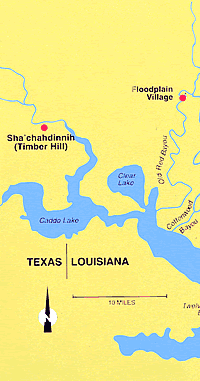
Locations of Caddo villages in the
Caddo Lake-Shreveport vicinity, 1795-1842, including
the site of Sha'chahdínnih (Timber Hill). Graphic
by Roland Pantermuehl, Texas Historical Commission.
|

Crew member Derek Edmonds, who traces
his ancestry through both Caddo and Wichita Indian lines,
participated in the full week of excavations. He learned
Caddo ways, songs, dances, and traditions beginning
in early childhood and shared these with the crew. Photo
courtesy Marion County Historical Society.
|
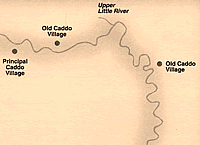
Caddo villages on the Great Bend
of the Red River prior to the settlement of Sha'chahdínnih,
as shown on Nicholas King's map of the Freeman-Custis
expedition of 1806. (Library of Congress).
|
|
Kadohadacho warriors …are brave, despise danger
or death, and boast that they have never shed white
men's blood.
-John Sibley, Nachitoches physician and Indian agent,
1805.
|
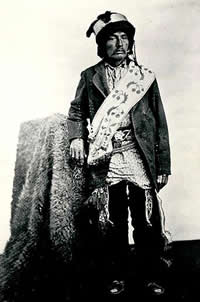
Caddo chief Show-e-tat, or "Little Boy." Born
in 1816, possibly at Timber Hill, he was also known as
George Washington. Photo circa 1868-1872, courtesy National
Anthropological Archives, Smithsonian Institution (Negative
No. 43944). |
|
The village on the lake became a place of crying.
-Caddo historian Cecile Elkins Carter.
|
|
Deep in the swampy woods of East Texas
near the Louisiana border, Texas Historical Commission archeologists
found some pieces of broken pottery and glass, a handful of
beads, a couple of buttons, and other odds and ends. It wasn't
much, but they knew they had finally solved an old mystery,
the exact location of a certain Caddo Indian village occupied
from 1800 to about 1840. The collection of artifacts, though
meager, was doubly precious to some of the volunteers on the
excavation crew—descendants of the 19th-century inhabitants
of the settlement. Called Sha'chahdínnih (Timber Hill),
it was the last village of the Kadohadacho Caddos in their
native homeland, a place still of great emotional and spiritual
importance to modern Caddos. It contains the last vestiges
of more than a thousand years of Caddo occupation of Texas,
which came to an end in 1859 when they were removed from a
north central Texas reservation to Indian Territory, now Oklahoma.
The village itself was not very old when it
was abandoned—Caddos had lived there for some 40 years.
The original home of the Kadohadachos centered on the Great
Bend of the Red River, but smallpox and Osage Indian attacks
had forced them to move time after time down the Red River.
By the time these moves began in 1788, the core
group, called the Cadodacho or Grand Caddo, had consolidated
with several formerly distinct Caddo villages in the vicinity
to form the cultural unit known as the Kadohadacho, and as
they moved downriver they absorbed another closely related
population, the Petit Caddo. Once in their Timber Hill village,
the Kadohadachos sympathetically allowed other Native American
immigrants into their territory, most notably the Coushattas
and Alabamas, who had been driven west by continuous white
pressure.
What forced the move to Timber Hill was nothing
less than a natural disaster—a huge mass of timber and
debris that dammed up the Red River, forcing water out of
its banks and onto the surrounding land. This "Great
Raft" created Caddo Lake. The Kadohadachos could see
that their village, which was on a floodplain, would soon
be inundated, so in 1800 they sought safer ground.
The People of Timber Hill
The Kadohadacho were one of three major Caddo
divisions. The other two were the Hasinai and the Natchitoches.
The Hasinai were the most numerous, but the Kadohadachos were
said to be the most respected among other Caddos. By the time
they had been at Timber Hill for five years, their numbers
had been reduced to about 450 adults, but the Kadohadachos
still exercised a great deal of authority over related tribes.
John Sibley, a Natchitoches physician and Indian agent, wrote
in 1805 that the Kadohadacho warriors were "looked upon
somewhat like the Knights of Malta, or some distinguished
military order. They are brave, despise danger or death, and
boast that they have never shed white men's blood."
Not only did they pride themselves on not killing
European settlers, the Caddos had long acted as intermediaries
between the Europeans and other tribes, as well as among the
various tribes of the region. They were considered important
political and economic allies by the governments of France,
Spain, Mexico, and the United States. During the time he lived
at Timber Hill, powerful Chief Dehahuit honored a request
from the Indian agency in Natchitoches to serve as a traveling
diplomatic ambassador to the tribes bordering Caddo territory.
His task was to persuade them to remain peaceful and friendly
toward both Americans and Spaniards while the two nations
were coming to terms over the Louisiana Purchase. Indian agent
Sibley described Dehahuit as "a remarkably shrewd and
sensible fellow."
Life at Timber Hill, aside from politicking,
was probably a cycle of traditional religious practices, farming—they
raised corn, beans, and pumpkins—and hunting. Every year
in November almost all the able-bodied men left for four months
to hunt on the buffalo plains to the northwest.
But by November of 1830, when Chief Dehahuit
led his men on the annual hunt, leaving behind women, children,
and old or disabled men, the village's situation was dire.
People were starving. Drought and flood had ruined their crops
year after year. Other tribes driven into Caddo territory
and Euro-American settlers had killed almost all the once-plentiful
game. Indian hunters from Timber Hill had already been decimated
by disease: The year they moved to the site, smallpox killed
almost half of them; three years later, measles took more.
"The village on the lake became a place of crying,"
wrote noted Caddo historian Cecile Carter.
All the while, settlers were pushing westward,
ever hungry for more land. The huge logjam that had forced
the Caddos to move from their floodplain village now protected
Timber Hill from encroachment, as it prohibited boat passage
on the middle Red River. But plans were underway to remove
the Great Raft—a battering-ram steamboat had been invented
to break it up. Work began in 1833, the same year Chief Dehahuit
died, and by April 1835 the Red was cleared, opening river
traffic all the way to Shreveport. Now nothing could stop
the white invasion of Caddo territory.
|
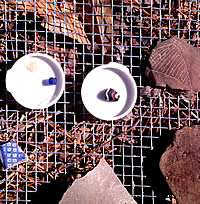
Artifacts, ranging from European-manufactured
ceramics and beads to pottery made by late Caddo peoples,
helped verify the location of the site of Sha'chahdínnih,
Timber Hill.
Click images to enlarge
|
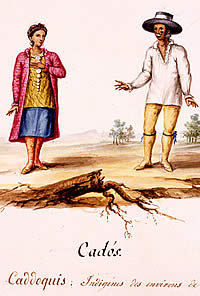
A Caddo couple in Nacogdoches, Texas,
in 1828 drawn by Lino Sánchez y Tapia after José
María Sánchez y Tapia. Courtesy Gilcrease
Museum, Tulsa.
|
|
This site represents the end of a culture in its
homeland after thousands of years.
-Dr. James Bruseth, Texas Historical Commission
|
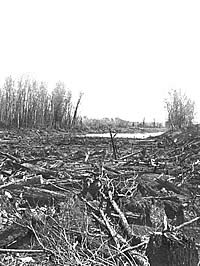
The "Great Raft," a huge mass of timber
that formed a logjam, dammed up the Red River and flooded
the surrounding area. Photo by R. B. Taylor, courtesy
Louisiana State University, Shreveport, Noel Memorial
Library Archives. |
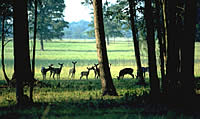
Deer on the edge of an East Texas
forest. During the time of Timber Hill, once-abundant
deer and other game were killed in large numbers by
encroaching immigrants to the Caddo lands, making conditions
even more perilous for the villagers. Photo courtesy
Texas Parks and Wildlife Department.
|
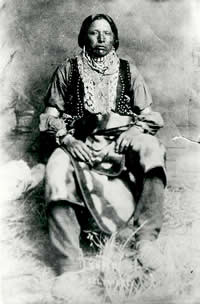
Enoch Hoag, last traditional chief of the Caddos (1896-1929).
Date of photo unknown. Courtesy National Anthropological
Archives, Smithsonian Institution. (Negative No. 1373b).
|
|